
MEASURE THE HORSE'S MOUTH FOR A LOOSE AND FIXED CHEEKPIECE



TAKE INTO ACCOUNT THE MOUTHPIECE
LOOSE
LOOSE & FIXED
1 BREAK
Add 10mm to allow the mouthpiece to set in the horses mouth.
SEMI-BROKEN
Add 5mm to allow the mouthpiece move slightly.
SOLID
The width of the mouthpiece should match the mouth.



MEASURE THE HORSE'S MOUTH FOR A LOOSE AND FIXED CHEEKPIECE
LOOSE
LOOSE & FIXED


“Pressure = resistance, resistance = lack of control”
A horse is an animal of flight – it will never yield to pressure or pain, it will either move away from it or run away. To obtain control we need to remove the resistance. To remove the resistance, one must remove the pressure or distribute the pressure over a larger surface area.


INTERDENTAL SPACE
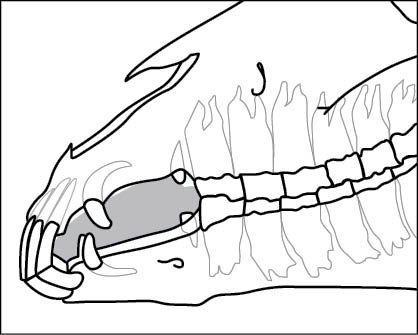

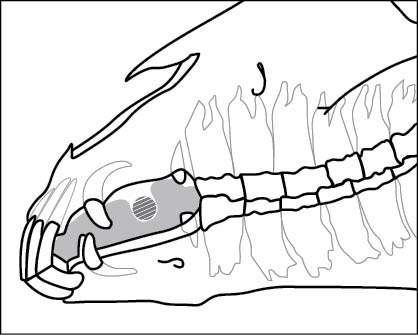

HOW TO FIT A BIT
Getting the fit of the bit correct is vitally important to the horse’s comfort. A bit that is far too small can cause pinching of the lips, but a bit that is too large can cause even more problems.
We have only been taught to look at how the bit fits the outside of the lips, without any consideration of how the bit functions inside of the mouth. When the mouthpiece is too large, the joints move, and the curves can sit incorrectly in the mouth. This leads to the mouthpiece applying pressure to areas it should not be.
An oversized bit will also create too much movement in the mouth. Allowing the bit to slide from side to side through the mouth. This movement causes discomfort as well as a background noise to the rider’s aids. When it comes to selecting the correct size, we need to take into account the horse’s actual mouth measurement but also consider how fleshy the lips are, how wide the lower jaw is and where the horses teeth are in relation to where the bit will sit.
Get in touch to learn more… here is to happy horses.
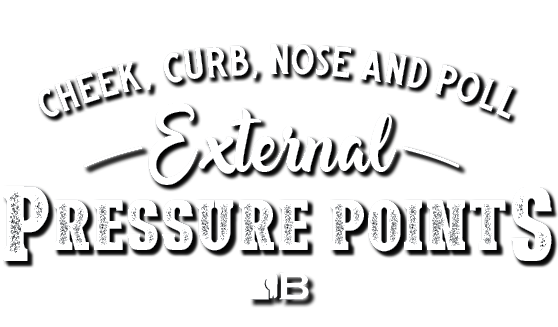

CHEEK
All cheekpiece, whether intentionally or not exert pressure on the cheek to encouraging flexion.
Fixed cheekpieces are designed to encourage flexion, sitting close to the cheeks with a smooth surface.
Loose cheekpieces should be slightly removed from the lips.
CURB
Curb pressure is exerted through a back strap or curb chain. Curb pressure is used in conjunction with leveraging the mouthpiece and optionally nose and poll pressure.
A back strap sits higher than the curb chain exerting a softer pressure, the back strap also secures the bit in place and can regulate when the poll is engaged, and the mouthpiece is leveraged. It also adds a third place for pressure to be dissipated.
NOSE
The area where the nasal bone ends and the cartilage begins, is covered by a very thin layer of skin, and therefore sensitive, care must be taken to ensure pressure is not placed on the cartilage.
Pressure to the nose will encourage flexion at the poll.
Bombers only has one cheekpiece which incorporates nose pressure. The Bombers Hybrid
POLL
Pressure on the poll encourages the horse to lower its head and flex. When flexed into a frame, the horse will engage its neck, back and hind, which will create more power in motion.
Bomber suggests placing your hand underneath the bridle where the poll is. Simulate the rein action to experience for yourself the pressure exerted.
BAR
Bar pressure is generally well received and will encourage poll flexion.
Bomber recommends moving the bits pressure to the bars while providing tongue relief.
LIPS
The length of the smile will also determine where the bit sits. Optimal being in front of the premolars over the widest section of the lower bars.
Fleshy lips can also be squeezed slightly with a fixed cheekpiece, to achieve a snug fit.
PINCH
All broken bits create some pinch.
Single break bits such as the snaffle create the most pinch.
Double break bits all create some pinch, determined by the width of the centre component.
TONGUE
All bits place some tongue pressure which encourages flexion at the poll.
Aim for a relaxed tongue and jaw. This will translate to a relaxed neck, leading onto a relaxed back and free-moving hindquarter and shoulder.
BAR
Bar pressure is generally well received and will encourage poll flexion.
Bomber recommends moving the bits pressure to the bars while providing tongue relief.
LIPS
The length of the smile will also determine where the bit sits. Optimal being in front of the premolars over the widest section of the lower bars.
Fleshy lips can also be squeezed slightly with a fixed cheekpiece, to achieve a snug fit.
PINCH
All broken bits create some pinch.
Single break bits such as the snaffle create the most pinch.
Double break bits all create some pinch, determined by the width of the centre component.
TONGUE
All bits place some tongue pressure which encourages flexion at the poll.
Aim for a relaxed tongue and jaw. This will translate to a relaxed neck, leading onto a relaxed back and free-moving hindquarter and shoulder.
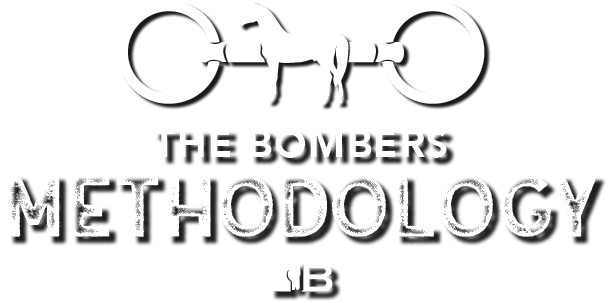

The Goal of bitting
Conformation
Internal factors
- Palate
- Tongue
- Canine, premolars & smile
- Wolf Teeth
- Lips, Jowls & Cheeks
- The Lower Jaw
External factors
- TMJ
- Neck
- Back
- Teeth
- Lameness
- General condition
- Composure








































CENTRE LINKS
BARREL
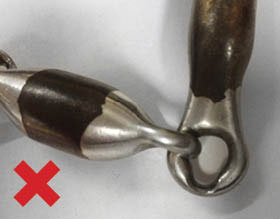





BARREL








SERIOUS
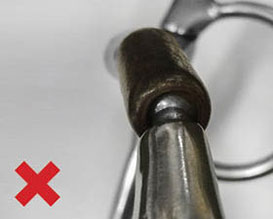

MODERATE
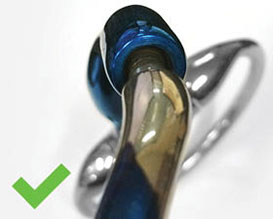

GOOD
Horse riding is an action sport, the rider’s safety greatly depends on the integrity of the equipment


MAX 90 KG
Bombers prides itself on striving to ensure the highest level of manufacturing and craftmanship. It is for that reason we have added a maximum weight rating of 90kgs on certain bit models, namely the barrel, Bomber Blue and cable mouthpieces.
CHEWABLE - NO GUARANTEE
Some mouthpieces are not suitable for horses that chew – no guarantee is offered on wear and tear of these materials:
- Cable
- Leather
- Flexible Tube
- Bomber Blue
- Moulded
MOVING PARTS WEAR
Mouthpieces that have joints will wear over time. Check your Bombers Bit before use, send us a image if you would like it to be assessed. Brass is a soft metal and will wear quicker over time.
OXIDISATION
Please note due to oxidisation the blue sweet iron will fade with use.
STAINLESS STEEL, SWEET IRON & BRASS
Bombers only uses the very best Stainless Steel. Brass is used in some products. Most of our mouthpieces are made from blue sweet iron, because it:
- oxidises easily
- encourages salivation
- helps bit acceptance
- is warm and sweet
Our bits should be washed after every use and checked for wear. If the bit has been out of use for some time, a kitchen scourer maybe necessary to remove built up oxidation.
LEATHER
100% natural leather mullen shape will incur strong tongue and some bar pressure. Suitable for horses that object to metal. Wipe the leather after every use with a clean, dry cloth and apply a leather conditioner regularly.
- Avoid soaking the leather in water or soap.
- Avoid using any cleaning products not designed for leather.
- Avoid storing leather bits in direct sunlight.
CABLE
Bomber’s revolutionary Cable bits
- Removes the centre links, creating a smooth more comfortable mouthpiece
- Offers a rigidity limiting the nutcracker effect and has spring back
- The cable allows for some lateral independence between each rein
The cable tubing is manufactured from clear virgin flexible PVC compound. It is heavy metal free meaning non- toxic and the pigment is FDA approved.
Patent Number : 2015/07341
BOMBER BLUE
The nylon composite material is light in the mouth and encourages salivation while the port offers tongue relief. It is particularly well suited to horses that object to metal mouth pieces. The material is non-toxic with a stainless-steel core.
FLEXIBLE TUBE
A bespoke PVC tube offers an exceptionally soft option, by applying even pressure over the tongue and bars. Particularly suited to the horse that objects to metal. The Bombers tube is UV resistant, heavy metal free meaning it is non-toxic and the pigment is FDA approved.
MOULDED
The internal flexible stainless-steel cable core has been injection moulded with a bespoke non-toxic, UV resistant, FDA approved flexible synthetic material.
The Bombers moulded material has been uniquely developed, to ensure 3 key attributes: texture, durability and comfort.

